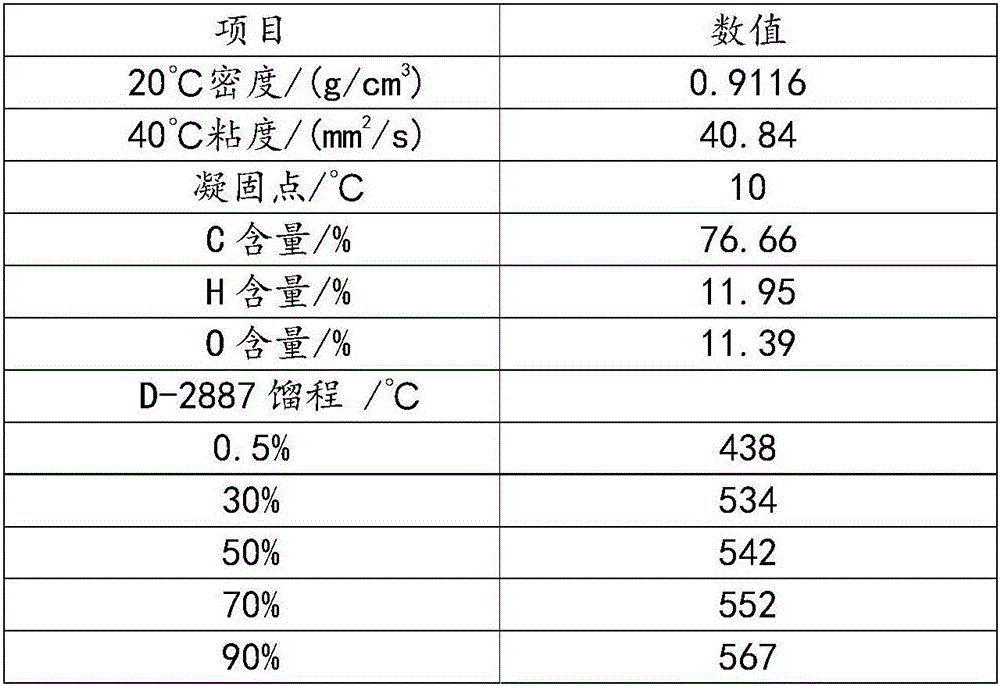Hydrodeoxygenation method of bio-oil
A hydrodeoxygenation, bio-oil technology, applied in chemical instruments and methods, metal/metal oxide/metal hydroxide catalysts, treatment of hydrocarbon oil, etc., can solve the problem of poor hydrothermal stability, easy aggregation and deactivation of catalyst active phases and other problems, to achieve the effect of not easy to run off, increase the dispersibility of acid and active phase, and improve the performance of sulfur fixation
- Summary
- Abstract
- Description
- Claims
- Application Information
AI Technical Summary
Problems solved by technology
Method used
Image
Examples
Embodiment 1
[0047] (1) Preparation of catalyst dry strips:
[0048] Take by weighing 1000 gram of dry rubber powder and 30 gram of asparagus powder and mix homogeneously, then add 900 milliliters of the aqueous solution that contains 28g nitric acid, extrude into the cylindrical wet strip of outer diameter φ 1.4mm on the plunger extruder. Then the cylindrical wet strip was dried at 120°C for 4 hours, and then calcined at 600°C for 3 hours to obtain carrier Z with a pore volume of 0.7mL / g and a specific surface area of 280m 2 / g.
[0049] Add 100g of ammonium heptamolybdate, 30g of nickel nitrate and 1000g of ammonia water into 400mL of aqueous solution, heat and stir until completely dissolved to obtain 500mL of impregnation solution. Take 400g of the above-mentioned carrier Z, spray all the above-mentioned impregnating liquid evenly on the carrier Z, then put the obtained semi-dry catalyst into an oven and dry it at 120°C for 4 hours to obtain the dry catalyst strip G1 impregnated wit...
Embodiment 2
[0060] (1) Preparation of dry catalyst strips: the same as in Example 1.
[0061] (2) Oxygenated organic matter treatment:
[0062] Place G1 in a ventilated vertical tube furnace, and roast at a constant temperature of 400°C for 3 hours. During the roasting process, the pre-configured aqueous solution with a phenol content of 7% by weight should be prepared according to the space velocity of 5h -1 , using a plunger pump to continuously push into the catalyst roasting bed layer, and finally obtain the catalyst C2 in the oxidation state. Wherein, relative to 100 parts by weight of dry catalyst strips, the mass of the aqueous solution introduced is 0.2 in total.
[0063] (3) Pretreatment before vulcanization
[0064] Phosphoric acid is selected as the VA oxygen-containing inorganic acid, and the total injection amount is 100g. Specifically, 100 g of phosphoric acid was mixed with 900 g of water to prepare a 10% by weight phosphoric acid aqueous solution. Under a nitrogen atmo...
Embodiment 3-7
[0070] The difference between embodiments 3 to 7 and embodiment 1 is that the metal active components are different, and the moles of the VIB group metal elements and the VIII group metal elements are all the same as those in the examples, and the compounds of the active components are respectively:
[0071] MoO 3 / CoCl 2 、WO 3 / CoCl 2 、WO 3 / Ni(NO 3 ) 2 、Cr 2 o 3 +MoO 3 (the two are mixed in equimolar) / CoCl 2 、Cr 2 o 3 +MoO 3 (the two are mixed in equimolar) / CoCl 2 +FeO.
PUM
| Property | Measurement | Unit |
|---|---|---|
| specific surface area | aaaaa | aaaaa |
Abstract
Description
Claims
Application Information
 Login to View More
Login to View More - R&D
- Intellectual Property
- Life Sciences
- Materials
- Tech Scout
- Unparalleled Data Quality
- Higher Quality Content
- 60% Fewer Hallucinations
Browse by: Latest US Patents, China's latest patents, Technical Efficacy Thesaurus, Application Domain, Technology Topic, Popular Technical Reports.
© 2025 PatSnap. All rights reserved.Legal|Privacy policy|Modern Slavery Act Transparency Statement|Sitemap|About US| Contact US: help@patsnap.com



